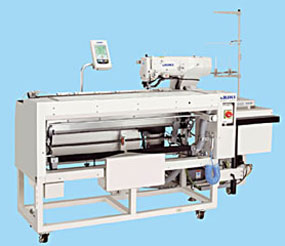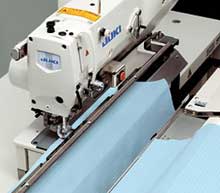Juki ACF-172-1790
Features
- High-speed, Computer-controlled Buttonholing Indexer
- A stepping motor controls material feed amounts in increments of 0.1mm to feed materials with both consistency and accuracy
- The machine is able to sew 1 to 20 buttonholes and stores 20 different stitching patterns in its memory
- When combined with a preset device and a garment-body stacker, the machine produces buttonholes with higher efficiency
- The maximum sewing speed has been increased to 4,200rpm
- The adoption of a direct-drive motor helps to increase accuracy of the machine's performance with respect to startup at the beginning of sewing and stopping at the end of sewing, thereby contributing to increased productivity
- Thanks to our advanced dry-head technology, no lubrication is required expect for the hook section
- This eliminates oil stains on the sewing product. Only a minute-quantity of clean oil is fed to the hook section from the oil tank
- The machine can be completely changed into a dry-head machine by replacing the hook with an optional non-lubricated hook. (In this case, the maximum sewing speed will be 3,300rpm.)
- A large color LCD touch panel has been adopted for the display
- It offers upgraded operability to facilitate the programming of sewing data
- In addition, data can be saved on SmartMedia or on a personal computer
- This means that data can be exchanged or shared with the LBH-1790, which is the general-purpose model, or among remote factories
- Complete with table stand and motor
| 

Juki ACF-172-1790
Computer-controlled Buttonholing Indexer
Call For Price:
(800)544-5858
| 
LBH-1790, high-speed, computer-controlled lockstitch buttonholing machine has been combined with a high-performance and highly accurate indexer.
|
With JUKI's unique active tension (electronic thread tension control mechanism), it is possible to change over the needle thread tension at parallel portions and bartacking portions of a buttonhole with reliability to finish with a beautifully stitched shape. In addition, a new-model thread trimming mechanism shortens the thread remaining at the end of a seam after thread trimming, thereby saving thread nipping. Furthermore, fastening stitches at the end of sewing prevent a seam from loosening.
|
|